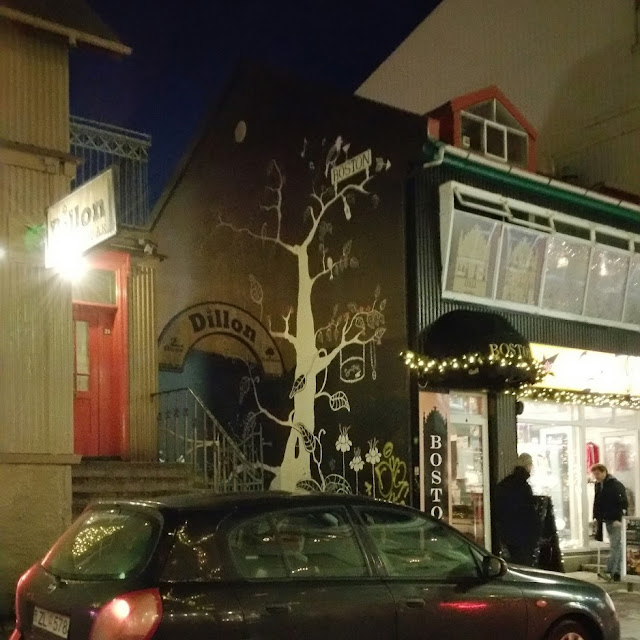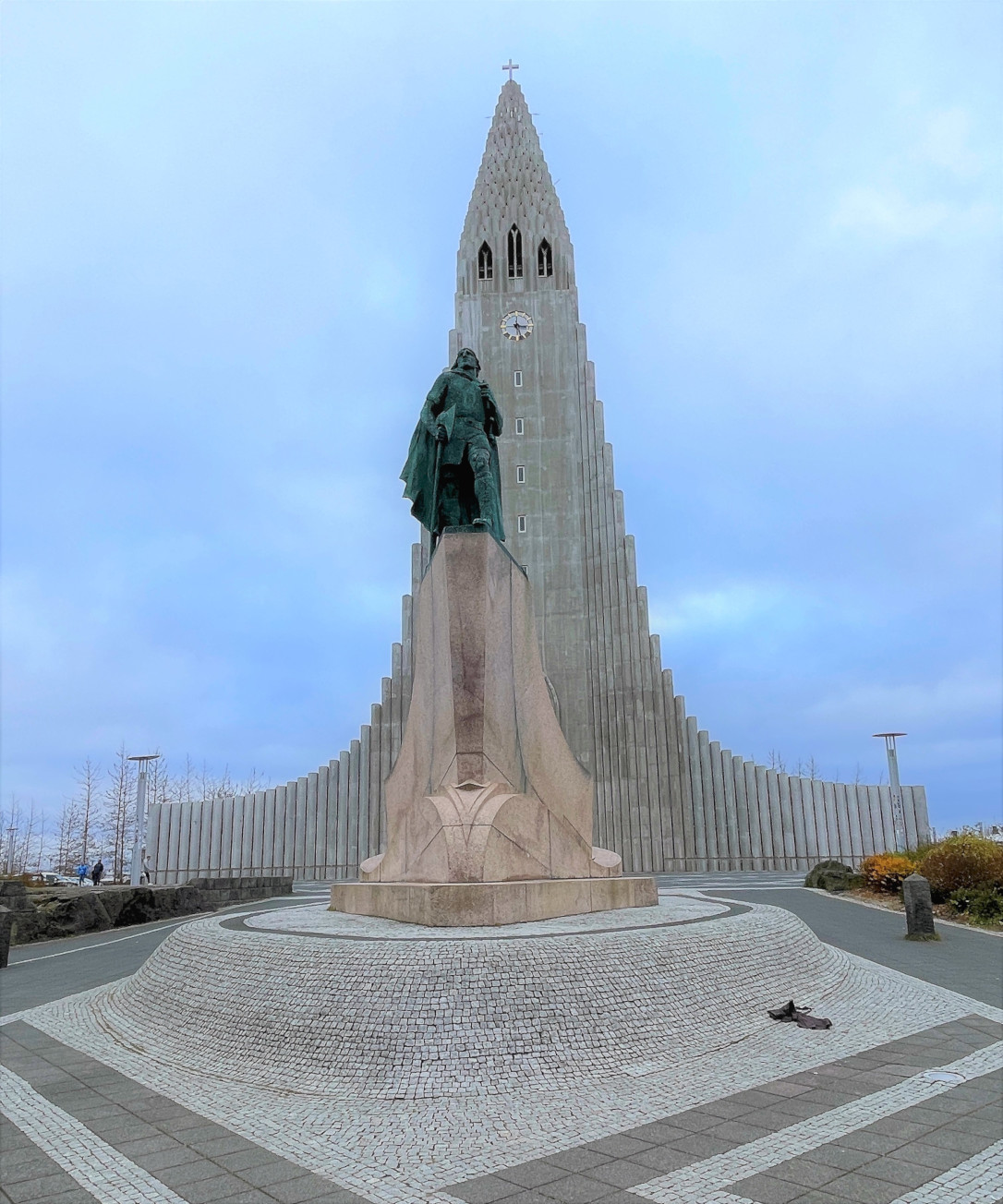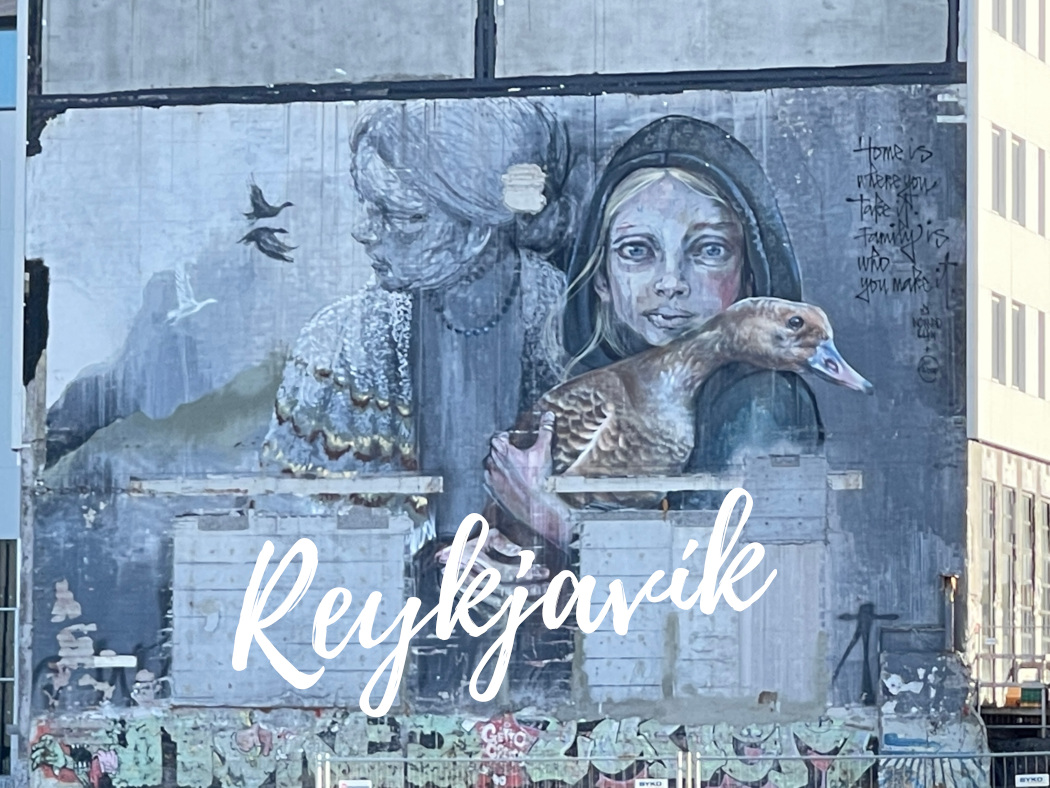 |
|
Dillon is a Whiskey bar located on Laugavegur 30. Their courtyard is next to Laugavegur 30b. The house is difficult to see from the street unless you enter Dillon’s courtyard.
|
Before the tourist explosion in Iceland, Laugavegur 30b was known by many locals as a party house. The type of people renting the apartments in the building usually brought with them loud music and paraphernalia. Today, the house has been cleaned up for tourists. It’s truly a perfect location for tourists as it’s very close to all the shops, pubs, museums and theaters. It is now known as Fálkinn Guesthouse.
In 1937, before the house became a party zone, it was just another house with good standing citizens as tenants. One of the tenants was Emil Tómasson (1881-1967). With an education in agriculture, he spent much of his younger years doing farm work. He was a very hard working and ambitious man, serving on various committees and writing multiple articles, especially on Icelandic wrestling (Glíma) and horses. He was a competitive wrestler himself and did very well. He had a passion for the sport and even authored a book about it.
In his younger years, Emil got himself a little puppy and named it Kolur. Shortly after, Emil started working as a teacher for children at a large farm. It was common back then to have teachers come stay on the farms to teach the children their bare essentials like reading and writing. Down in the basement was the kitchen. Emil made Kolur a box and filled it with hay. He then put Kolur inside his new bed and slid it under the oven in the kitchen.
Kolur rarely left his bed. A lot of people went through the kitchen during the day, but it was only when he heard Emil walking down the stairs that he jumped out of bed. When Emil wasn’t working, he took Kolur outside and played with him. They became very close and a special bond developed between the two.
When it came time to gather the sheep and cattle for the farmers, Emil approached them and suggested they take Kolur with them to help gather the sheep. This was always greatly appreciated until the farmers realized that the dog would only go with them for a short while before running back home to Emil. The farmers often cursed the dog and thought he was the dumbest animal there was. Emil never got frustrated with the dog, instead the bond between them became even stronger.
In the spring of 1912, Emil got his own farm and Kolur turned out to be an excellent sheepdog. It appeared that he had found his calling, running around making sure the sheep stayed put. Never once did one go astray while Kolur was on watch.
 |
| Icelandic sheepdog. Photo to the left by Zonjah and photo to the right by Unknown |
During unruly snowstorms where sheep would often be buried alive, the farmers had to go searching for those still alive and bring them to safety. Kolur was able to sense sheep that were buried under the snow and still alive. He saved many sheep from entrapment and starvation. All this made the bond between Kolur and Emil even stronger.
In March 1922, although still very much active and clear-minded, Kolur had started to age. Emil had to go on a long trip, beginning by taking a boat to the neighboring fjord. As always, Emil brought Kolur with him. The two of them got down to the pier and Emil jumped into the boat, expecting Kolur to follow right behind him. To his surprise, Kolur stayed behind on land. Startled by this change in behavior, Emil got out of the boat so he could carry the old dog on board. As much as he tried, Kolur wouldn’t let him pick him up and started moving away from the pier. Not wanting to keep the boat waiting, Emil went back on the boat confident that the dog would find his way home. As the boat left the pier, he watched Kolur standing in the same spot where they parted. Emil couldn’t shake this strange behavior in the dog and thought it most likely meant that his trip would be unfortunate or something bad would happen to the boat.
Almost two months later, Emil was finally home. Expecting to be greeted by Kolur, he was instead met with the news that his beloved dog had died. The day after Emil left on his trip, Kolur came home with a swollen and bloodied head. He refused to eat or drink and crawled straight into his bed where he stayed until he died a day later.
About 15 years and a few dogs later, in the summer of 1937, Emil had moved to Laugavegur 30b in Reykjavik. While there, he met a clairvoyant woman. They would often sit and talk about the hidden people and those who had passed on. Although Emil was fascinated by otherworldly matters, he was very cautious about believing everything he heard.
 |
| Dillon Whiskey bar on Laugavegur 30. The black house in the background is Laugavegur 30b. Photo by Gary J. Wood. |
 |
| Seen from Dillon’s courtyard. This photo is older than the one above. Most likely taken before it became a guesthouse for tourists. Here Laugavegur 30b is orange. Photo by Narisa. |
One summer evening in 1937, the woman came over to his house. She was very excited. She had been able to arrange a meeting with the medium, Hafsteinn Björnsson. Hafsteinn was one of Iceland’s most known mediums. The interest in his abilities reached other parts of the world, which resulted in him traveling to U.S.A. to be studied in controlled settings. The research can be found online here. Hafsteinn was a very sought after medium and it was unheard of to get an appointment on a short notice. This was an opportunity Emil couldn’t resist.
The medium, Emil and his guests all sat in a circle, as was the norm during séances at the time. Whatever occurred during the séance didn’t stick in Emil’s memory. It was what happened afterwards that he never forgot. After the séance, the guests visited with each other and made small talk. Emil and Hafsteinn were the only ones left sitting in the circle. They sat and discussed mysterious phenomenon. Emil was thoroughly enjoying the conversation, finding it very enlightening. He noticed that Hafsteinn kept looking over at the wall in the living room. All of a sudden in mid-conversation, Hafsteinn interrupted asking him if he ever owned a dog. Perplexed and caught off-guard, Emil’s mind was struggling to shift gears from deep discussions into life’s mysteries that he had answered ‘yes’ before realizing it. He had had many dogs, he told Hafsteinn.
Hafsteinn then told him he was looking at a medium size black good looking dog. Its ears were hanging down. The inside of the ears were yellow with golden edges. His eyelids were yellow too. The eyebrows were unusually thick and furry. The dog’s chest was a yellowish-white color and the legs were black in front, but yellow in back. The underside of the tail was white. Hafsteinn didn’t understand what he was seeing, because the dog was acting strange. He was standing towards the bottom of a heather-covered steep hill. There’s a large field covering an area between many farms. The dog was walking slowly back and forth. He then sat down on the tallest hill and looked down at the farms. It looks like he was in some kind of trouble or was experiencing an inner battle, but Hafsteinn couldn’t quite understand what he was seeing.
Emil was speechless. He couldn’t have described Kolur in any more detail if he was sitting on his lap. He knew right away what he was describing. He explained to Hafsteinn that he used to have a dog and during sheep gathering he’d lend the dog to the other farmers to help them. Kolur always went off willingly with the farmers, but never followed through helping them. He always returned home prematurely. This angered the farmers quite a bit, because the gathering the sheep would have been so much easier if the dog helped. They cursed and yelled at Kolur. Emil felt he now understood how torn this made the dog feel. He was battling within himself. On one end he had his unwavering dedication to Emil and on the other end, the fear of betraying the farmers when they needed him.
Hafsteinn wasn’t done yet. He asked Emil if he had ever owned a horse that he loved dearly. Emil said he had. Then Hafsteinn explained that for a while now he had been looking at a horse’s head and the strange thing was that no matter how hard he tried, he could only see his head and neck. The rest of the body was completely hidden. It was like there was a dark mist covering it. The head was large and beautiful. He could tell the horse was well taken care of. Its eyes were large and bright and constantly looking at Emil. Hafsteinn was surprised of how eager the horse was to get in touch with him.
 |
| The Icelandic horse. Kári was reddish-brown in color. Photo to the left by Thomas Quine and photo to the right by Marc-Lautenbacher. |
There was no doubt in Emil’s mind that he was talking about Kári, a horse he deeply loved and missed. The two of them were inseparable and had developed a strong bond. He hadn’t seen the horse for over two years. Emil had not been a wealthy farmer and in order to take care of his family, he had taken out a loan. Not quite understanding how deceitful loan contracts could be, he didn’t realize he had put a lien on his horse. One day when Emil was in the stable feeding his horse, they came to collect him as a payment on the loan. He watched as Kári happily trotted next to the man with his beautiful mane blowing in the wind. His eyes swelled up with tears. Emil didn’t know it then, but it was the last time he’d ever see Kári.
Soon after, Emil moved his family to Reykjavik. He thought often about Kári and missed riding him. He never stopped wondering how his horse was doing. One day he met a man who knew of his horse. He told Emil that the horse was constantly running away and twice he had tried swimming over Lagarfljót (River in West Iceland).
The following year, Emil was having difficulty finding out how more news on Kári. He was worried about his welfare, especially after what he had previously heard. In the summer of 1936, Emil met another man who knew of the horse. The man callously told him that Kári had died. He had ran away and tried to cross the same river, but fell through the ice and drowned. The news weighed heavy on Emil and he mourned the horse deeply.
Emil never forgot his meeting with Hafsteinn and the mysteries into the afterlife were even deeper than he had ever thought. There was no doubt in his mind that Hafsteinn truly did see the animals. What he didn’t understand was why does this happen?
Sources:
Fálkinn Guesthouse
Emil Tómasson
The story pp. 33-36.
The story (2)
The story (3) pp.41-45.
The story (4) pp.25-27 Research into Hafsteinn Björnsson




